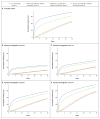Frequency of Evidence-Based Screening for Retinopathy in Type 1 Diabetes
- PMID: 28423305
- PMCID: PMC5557280
- DOI: 10.1056/NEJMoa1612836
Frequency of Evidence-Based Screening for Retinopathy in Type 1 Diabetes
Abstract
Background: In patients who have had type 1 diabetes for 5 years, current recommendations regarding screening for diabetic retinopathy include annual dilated retinal examinations to detect proliferative retinopathy or clinically significant macular edema, both of which require timely intervention to preserve vision. During 30 years of the Diabetes Control and Complications Trial (DCCT) and its longitudinal follow-up Epidemiology of Diabetes Interventions and Complications (EDIC) study, retinal photography was performed at intervals of 6 months to 4 years.
Methods: We used retinal photographs from the DCCT/EDIC study to develop a rational screening frequency for retinopathy. Markov modeling was used to determine the likelihood of progression to proliferative diabetic retinopathy or clinically significant macular edema in patients with various initial retinopathy levels (no retinopathy or mild, moderate, or severe nonproliferative diabetic retinopathy). The models included recognized risk factors for progression of retinopathy.
Results: Overall, the probability of progression to proliferative diabetic retinopathy or clinically significant macular edema was limited to approximately 5% between retinal screening examinations at 4 years among patients who had no retinopathy, 3 years among those with mild retinopathy, 6 months among those with moderate retinopathy, and 3 months among those with severe nonproliferative diabetic retinopathy. The risk of progression was also closely related to mean glycated hemoglobin levels. The risk of progression from no retinopathy to proliferative diabetic retinopathy or clinically significant macular edema was 1.0% over 5 years among patients with a glycated hemoglobin level of 6%, as compared with 4.3% over 3 years among patients with a glycated hemoglobin level of 10%. Over a 20-year period, the frequency of eye examinations was 58% lower with our practical, evidence-based schedule than with routine annual examinations, which resulted in substantial cost savings.
Conclusions: Our model for establishing an individualized schedule for retinopathy screening on the basis of the patient's current state of retinopathy and glycated hemoglobin level reduced the frequency of eye examinations without delaying the diagnosis of clinically significant disease. (Funded by the National Institute of Diabetes and Digestive and Kidney Diseases and others; DCCT/EDIC ClinicalTrials.gov numbers, NCT00360893 and NCT00360815 .).
Figures
Comment in
-
Screening for Diabetic Retinopathy.N Engl J Med. 2017 Apr 20;376(16):1587-1588. doi: 10.1056/NEJMe1701820. N Engl J Med. 2017. PMID: 28423293 No abstract available.
-
Frequency of Evidence-Based Screening for Diabetic Retinopathy.N Engl J Med. 2017 Jul 13;377(2):194-195. doi: 10.1056/NEJMc1706322. N Engl J Med. 2017. PMID: 28700835 No abstract available.
Similar articles
-
Effects of Prior Intensive Insulin Therapy and Risk Factors on Patient-Reported Visual Function Outcomes in the Diabetes Control and Complications Trial/Epidemiology of Diabetes Interventions and Complications (DCCT/EDIC) Cohort.JAMA Ophthalmol. 2016 Feb;134(2):137-45. doi: 10.1001/jamaophthalmol.2015.4606. JAMA Ophthalmol. 2016. PMID: 26584339 Free PMC article. Clinical Trial.
-
Prolonged effect of intensive therapy on the risk of retinopathy complications in patients with type 1 diabetes mellitus: 10 years after the Diabetes Control and Complications Trial.Arch Ophthalmol. 2008 Dec;126(12):1707-15. doi: 10.1001/archopht.126.12.1707. Arch Ophthalmol. 2008. PMID: 19064853 Free PMC article. Clinical Trial.
-
Refractive Error and Retinopathy Outcomes in Type 1 Diabetes: The Diabetes Control and Complications Trial/Epidemiology of Diabetes Interventions and Complications Study.Ophthalmology. 2021 Apr;128(4):554-560. doi: 10.1016/j.ophtha.2020.09.014. Epub 2020 Sep 14. Ophthalmology. 2021. PMID: 32941962 Free PMC article. Clinical Trial.
-
Prognostic factors for the development and progression of proliferative diabetic retinopathy in people with diabetic retinopathy.Cochrane Database Syst Rev. 2023 Feb 22;2(2):CD013775. doi: 10.1002/14651858.CD013775.pub2. Cochrane Database Syst Rev. 2023. PMID: 36815723 Free PMC article. Review.
-
Epidemiological issues in diabetic retinopathy.Middle East Afr J Ophthalmol. 2013 Oct-Dec;20(4):293-300. doi: 10.4103/0974-9233.120007. Middle East Afr J Ophthalmol. 2013. PMID: 24339678 Free PMC article. Review.
Cited by
-
Novel strategy for screening of diabetic retinopathy.J Diabetes Investig. 2018 Jul;9(4):726-727. doi: 10.1111/jdi.12770. Epub 2017 Dec 21. J Diabetes Investig. 2018. PMID: 29091350 Free PMC article. No abstract available.
-
To Determine the Risk-Based Screening Interval for Diabetic Retinopathy: Development and Validation of Risk Algorithm from a Retrospective Cohort Study.Diabetes Metab J. 2025 Mar;49(2):286-297. doi: 10.4093/dmj.2024.0142. Epub 2024 Oct 31. Diabetes Metab J. 2025. PMID: 39478439 Free PMC article.
-
Type 1 Diabetes in Children and Adolescents: A Position Statement by the American Diabetes Association.Diabetes Care. 2018 Sep;41(9):2026-2044. doi: 10.2337/dci18-0023. Epub 2018 Aug 9. Diabetes Care. 2018. PMID: 30093549 Free PMC article. No abstract available.
-
Prevalence of diabetic retinopathy in children and adolescents at an urban tertiary eye care center.Pediatr Diabetes. 2020 Aug;21(5):856-862. doi: 10.1111/pedi.13037. Epub 2020 May 31. Pediatr Diabetes. 2020. PMID: 32410329 Free PMC article.
-
Integration of genomics and transcriptomics predicts diabetic retinopathy susceptibility genes.Elife. 2020 Nov 9;9:e59980. doi: 10.7554/eLife.59980. Elife. 2020. PMID: 33164750 Free PMC article.
References
-
- National diabetes fact sheet, 2011: national estimates and general information on diabetes and prediabetes in the United States. Atlanta: Centers for Disease Control and Prevention; 2011.
-
- The Diabetes Control and Complications Trial Research Group. The effect of intensive treatment of diabetes on the development and progression of long-term complications in insulin-dependent diabetes mellitus. N Engl J Med. 1993;329:977–86. - PubMed
-
- UK Prospective Diabetes Study (UKPDS) Group. Intensive blood-glucose control with sulphonylureas or insulin compared with conventional treatment and risk of complications in patients with type 2 diabetes (UKPDS 33) Lancet. 1998;352:837–53. - PubMed
Publication types
MeSH terms
Substances
Associated data
Grants and funding
LinkOut - more resources
Full Text Sources
Other Literature Sources
Medical

